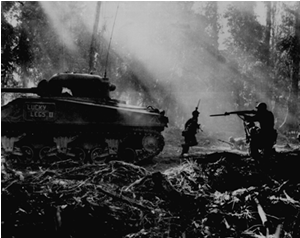Brightwood Boys, The History of the Men from
the North End of
Springfield, Massachusetts,
During World War II
by Christopher P. Montagna
CHAPTER 9
BOUGAINVILLE
Two days after the initial landing on Bougainville, Marine Corps Sgt. Chester "Chet" Sadowski was aboard a Navy LST approaching the landing beach. Prior to joining the Marine Corps Chester lived on Orchard Street. He was the son of Peter and Helen (Wichrowski) Sadowski and enlisted in the Marines on May 20, 1942. Chet conveyed his experiences of that day and his time in the Marines in a letter written to a military historian in 1982.
 "I boarded the train for Parris Island on May 22, 1942. When we got to Penn Station in New York, they put us in a coach that must have been from the Civil War. It had wooden benches that were thinly padded. There was a pot belly stove at each end of the coach and swinging kerosene lamps in the center of the isle about six feet apart."
"I boarded the train for Parris Island on May 22, 1942. When we got to Penn Station in New York, they put us in a coach that must have been from the Civil War. It had wooden benches that were thinly padded. There was a pot belly stove at each end of the coach and swinging kerosene lamps in the center of the isle about six feet apart."
Chet spent eight weeks training with Platoon #378 at Parris Island and after basic training was sent to motor transport school at Quantico, Virginia. After six months serving in a motor pool unit, Chet requested to be transferred to a combat unit. Eventually, Chet met an Officer who was returned from Guadalcanal and who arranged for Chet's re-assignment to a special weapons battalion, anti-tank unit with the 23rd Marine (Reinforcement). In March of 1943, Chet embarked a troopship for the American Samoa.
Chet arrived in American Samoa on March 24, 1943 and trained under tropical conditions. As he recalled, "[It] was our first experience with coconuts and lizards. If we weren't wet from the rain, we were from sweating. [We] made amphibious landings on British Samoa and were ready for combat. [The] next thing we found out they issued us long wool underwear. We were shipped to Auckland, New Zealand, it was winter there, for additional training. [We] finally landed at Guadalcanal and trained with the 3rd, 21st, 9th and 12th Marines in preparation for the invasion of Bougainville".
As Chet approached the Bougainville beach, his landing craft passed bombed destroyers and was strafed several times by Japanese gunners. "By the time we were assigned an area to be stationed it was too late to dig a foxhole, so we had to duck under our half-tracks from the bombings. The beach was so close to sea level that any foxhole dug below six-inches would fill with water. We dug to two-feet, so if we used the foxhole you would be filled with water. We used the foxhole twice when bombs were too close. Most of the time we hid behind a "banana leave" [because] it wasn't worth being that wet all night".
 The Yanks mop up on Bougainville. At night the enemy would infiltrate American lines. At Dawn, the doughboys went out and killed them. This photo shows tank going forward, infantrymen following in its cover." March 1944
The Yanks mop up on Bougainville. At night the enemy would infiltrate American lines. At Dawn, the doughboys went out and killed them. This photo shows tank going forward, infantrymen following in its cover." March 1944
Chet Sadowski participated in active operations against the Japanese at Bougainville. Again, in his own words: "After two days we noticed the "CB's" were bulldozing a coconut grove. It was for an airstrip for Pappy Boyington's "Black Sheep" squadron. We helped the CB's lay the pieces planking for the strip. There was never much tank activity on the island, so we filled in on any mission that lacked manpower. Our machine gun section was on the line the whole time".
After four months engaging the enemy at Guadalcanal, Nino Montagna and Billy Wright were evacuated from the island aboard the USS Hunter Ligett at Guadalcanal on December 13, 1942. The ship sailed that same date and arrived at Brisbane, Australia on December 19th. The Marines spent Christmas 1942 aboard ship and finally disembarked on December 26, 1942. The Battle of Guadalcanal continued for another two months. The island was finally secured in February 1943. The American forces lost more than 7,100 marines, sailors, and soldiers in battle, in and around the island.
On January 12, 1943, Nino Montagna's Company B, 1st Engr Bn , 1st Mar Div, designation changed to Co B, 1st Bn, 17th Mar (Engr), 1st Mar Div, Fleet Marine Force (FMF). Nino once again embarked a troopship, this time aboard the USS West Point at Brisbane on January 8, 1943. On January 10, 1943, the ship set sail and arrived in Melbourne, Australia on January 10, 1943. The West Point arrived and disembarked at Melbourne on January 12, 1943. Nino and the other members of his Company would spend the next eleven months in Melbourne as the military command developed the operational plans for the war in the Pacific.